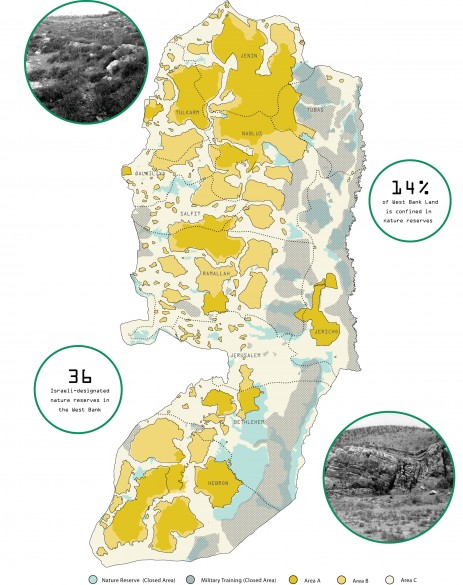Architects help envision Palestine’s landscape after apartheid
 Thursday, August 8, 2013 at 10:11PM
Thursday, August 8, 2013 at 10:11PM Submitted by Nora Barrows-Friedman 8 August 2013 - 20:33 The Electronic Intifada

A fascinating, in-depth interview with a former researcher of Decolonizing Architecture was published this week by Toronto-based writer and interviewer Justin Podur.
A collective of architects and artists doing political work on the ground in occupied Palestine, Decolonizing Architecture’s work “combines discourse, spatial intervention, education, collective learning, public meetings and legal challenges … It proposes the subversion, reuse, profanation and recycling of the existing infrastructure of a colonial occupation,” according to its website.
In recent years, members of the Decolonizing Architecture collective have worked in the occupied West Bank to reclaim land and, envisioning for the future, re-map the land inside and around illegal Israeli settlement colonies in preparation for a post-apartheid era.
The project “deals with a fundamental question of how Israeli military bases could be reused, recycled or reorientated by Palestinians after the moment that the military power discharges it,” as co-founder Alessandro Petti explained to The Electronic Intifada in 2010.
TACTICAL AGENCY
In Podur’s interview, posted on YouTube and Podur’s blog (podur.org), former Decolonizing Architecture resarcher Suzy Harris-Brandts discusses some of the design strategies on which the collective worked, and she includes detailed maps and diagrams. She also talks about how subversive urban design to reclaim land formerly occupied by Israeli settlers, or destroyed by the Israeli army, can be implemented both today and once the occupation is over.
In addition, she talks at length about the ways in which waste management systems can be redesigned to fit within the current political, environmental and socio-economic landscape in local West Bank areas.
Harris-Brandts speaks of the way architects and architecture can offer “tactical agency” to Palestinians planning for their return and reclamation of their land. In poring over maps of militarized spaces and closed, controlled militarized zones, as well as the peripheral areas around the illegal settlements, she adds that:
Most of my research became dissecting how power operated through landscape, and then finding moments of subversion where both the absurdity of the kind of ardent attempt to keep power and segregation so strong could be challenged; and also where everyday practices could start to provide a moment of political agency.
There are many compelling moments of this interview, too many to list here. But Harris-Brandts’ discussion of her work and what drove her research is fascinating. It offers an important look about the intersection between physical space and military occupation — and how people are working to reverse the destruction and reconceptualize the relationship between persons and their land.
More of Harris-Brandts’ work can be found here.
The Ossington Circle is a new interview show broadcasting out of Toronto, Canada, offering a progressive, thoughtful and informed take on international politics. Host Justin Podur is a writer on international politics and analysis, and the author of Haiti’s New Dictatorship: The Coup, the Earthquake and the UN Occupation. Recent episodes have featured Middle East journalist and analyst Jon Elmer, and John Clarke from the Ontario Coalition Against Poverty.
PALESTINIAN ARCHITECT SHORTLISTED FOR AWARD
In related news, the Royal Institute of British Architects (RIBA) has shortlisted Yara Sharif, Associate Lecturer for the Oxford Brookes School of Architecture, for RIBA’s President’s Awards for Research 2013 in the Outstanding PhD Thesis category.
Oxford Brookes University stated that Sharif’s thesis, “Searching for Spaces of Possibilities and Spaces of Imagination within the Palestinian/Israeli Conflict,” is a culmination of her research over the past seven years “with the aim to identify a potential architecture of resistance in Palestine. Her PhD rethinks the Palestinian/Israeli situation through an investigation of everyday spaces that exist between people, maps, documents and boundary lines. Using a combination of writing and design interventions, the thesis outlines possibilities for re-empowering a fragmented society and bridging gaps within the divided territory of Palestine’s West Bank.”
Yara Sharif explained:
Being Palestinian myself, I bring in local voices and narratives of those who daily have to occupy the resulting spaces yet are also alienated from most analyses of the context. Specifically, I investigated informal forms of resistance and tactics of survival which, at a subversive and invisible micro-scale, are cutting into the heart of Israel’s occupation strategy.
… For me, it is fantastic news to be shortlisted but equally it is an important step forward in terms of research as I do believe there is a need to offer an alternative and most importantly a local voice, which the research aims to address.
 APJP |
APJP |  Post a Comment |
Post a Comment |